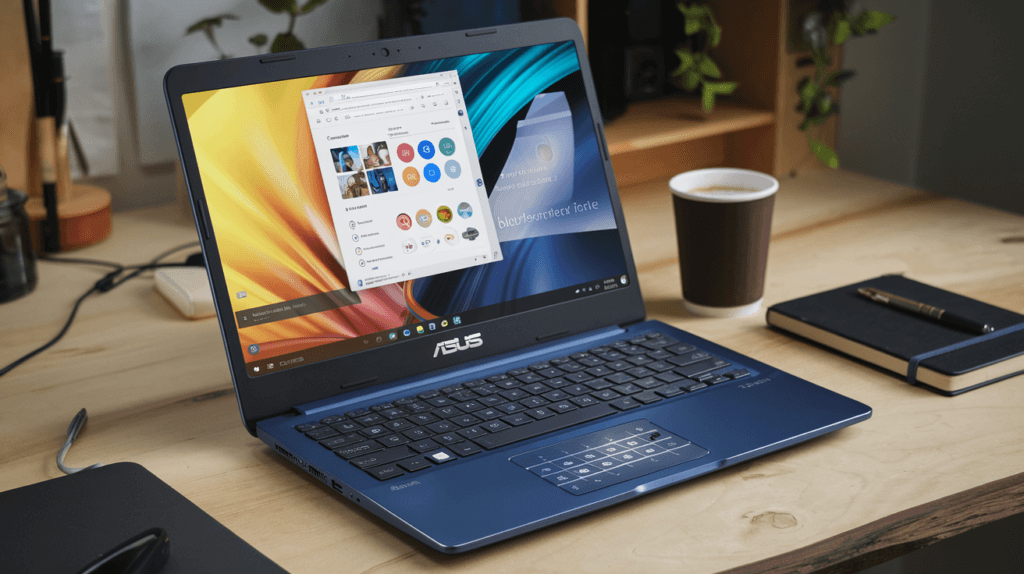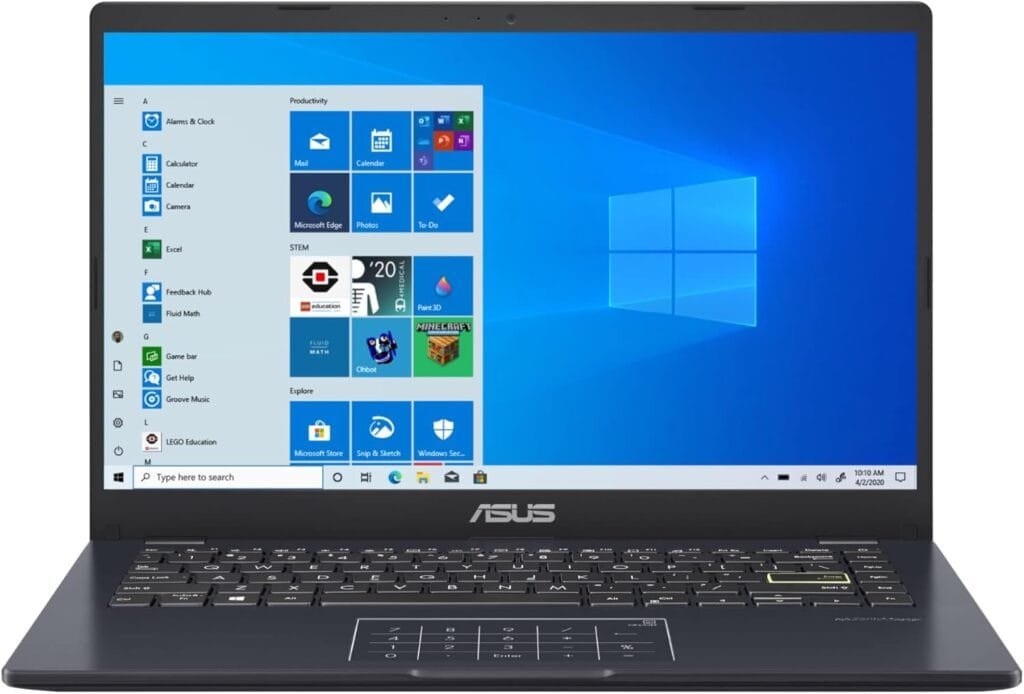Ever been stuck between wanting a laptop that won’t break the bank but also won’t break down after a month of use? That’s exactly where I found myself last semester when my ancient Dell finally gave up the ghost right in the middle of finals week (talk about timing!). After a panic-filled weekend of research and way too many comparison charts, I decided to take a chance on the ASUS E410. Six months later, I think I’m finally ready to share my complete, no-holds-barred review of this budget-friendly little machine.
First Impressions: More Than Just Another Budget Laptop
When the ASUS E410 first arrived at my doorstep, I wasn’t expecting much. I mean, at this price point, you learn to temper your expectations. But I gotta say, ASUS managed to surprise me right out of the box.
The laptop comes in this really nice peacock blue color (though there are other color options available), which immediately sets it apart from the sea of black and silver laptops that dominate the budget category. It’s refreshingly different without being garish or screaming “I’m trying too hard to be unique!”
At just 3.3 pounds and with a profile of 0.7 inches, the E410 is remarkably portable. I can easily slip it into my backpack and barely notice the weight during my commute to the coffee shop where I do most of my writing. The build quality is primarily plastic, but it doesn’t feel cheap or flimsy like some other budget laptops I’ve tried in the past.
Unboxing and Setup Experience
The unboxing experience was pretty standard—laptop, power adapter, and some basic documentation. Setting up Windows was a breeze, though I did have to spend some time uninstalling the bloatware that came pre-installed (why is this still a thing in 2024?).
One thing that did catch my attention during setup was how quickly the laptop booted up. Even on first use, I was looking at the Windows desktop in under 30 seconds, which was a promising sign for performance.

ASUS E410 Specifications: What’s Under the Hood?
Before diving deeper into my experience, let’s take a quick look at what the ASUS E410 is packing:
- Processor: Intel Celeron N4020 (some models come with Pentium Silver N5030)
- RAM: 4GB DDR4 (soldered, not upgradeable)
- Storage: 128GB eMMC (some models offer 64GB or 256GB)
- Display: 14-inch HD (1366 x 768) LED-backlit display
- Graphics: Intel UHD Graphics 600
- Battery: 42Wh, up to 12 hours claimed battery life
- Ports: 1x USB-C 3.2, 1x USB-A 3.2, 1x USB-A 2.0, 1x HDMI, 1x microSD card reader, 1x 3.5mm audio jack
- Connectivity: Wi-Fi 5 (802.11ac), Bluetooth 4.1
- Operating System: Windows 11 Home (S Mode, but you can switch out)
- Weight: 3.3 pounds (1.5kg)
- Dimensions: 12.8 x 8.5 x 0.7 inches
On paper, these specs don’t exactly scream “powerhouse,” but they’re respectable for the price point. The big question is: how do they translate to real-world performance? Let’s find out.
Check out the latest price and availability of the ASUS E410 on Amazon
Performance: Managing Expectations
Let me be straight with you—if you’re looking for a laptop to edit 4K videos or play the latest AAA games, the ASUS E410 is not for you. But that’s not what this laptop is designed for.
In my day-to-day use—which includes writing articles like this one, browsing the web with multiple tabs open, streaming Netflix, and occasionally editing photos in Lightroom—the E410 performs… adequately. And I don’t mean that as a backhanded compliment.
The Celeron processor handles basic tasks without much fuss. Word processing, spreadsheets, and web browsing are all smooth experiences as long as you don’t go overboard with the number of programs or browser tabs you have open simultaneously. I’ve found that keeping it under 10 Chrome tabs is the sweet spot for maintaining responsiveness.
Where the limitations start to show is in more demanding tasks. Trying to edit photos in Lightroom leads to noticeable lag, especially when applying multiple adjustments. And forget about video editing beyond the most basic cuts and joins—it’s just not equipped for that kind of workload.
Multitasking Capabilities
The 4GB of RAM is really the bottleneck here. While it’s enough for basic multitasking, like having a Word document open alongside a few browser tabs, you’ll start to notice slowdowns if you push beyond that. The lack of RAM upgradeability is definitely a downside, as adding more memory would significantly improve the multitasking experience.
That said, I’ve developed a workflow that works around these limitations. I’m more mindful about closing unused applications, and I’ve switched from Chrome to Microsoft Edge, which seems to be more memory-efficient on this system.
Display Quality: Serviceable, Not Spectacular
The 14-inch HD display on the ASUS E410 is… fine. It’s not going to blow you away with vibrant colors or sharp details, but it gets the job done for everyday use. The 1366 x 768 resolution feels a bit dated in 2024 when even budget smartphones offer Full HD displays, but it’s adequate for a screen of this size.
Brightness is decent for indoor use, though you might struggle a bit in bright environments or outdoors. The matte finish helps reduce glare, which is a nice touch for a budget laptop.
Viewing angles are surprisingly good for a budget panel—I can still clearly see what’s on screen even when not sitting directly in front of it. This has been helpful when I need to show something to a friend or colleague without having to hand over the laptop.
Color Accuracy and Media Consumption
Color accuracy is where the display falls short. If you’re doing any kind of design work or photo editing where color accuracy is crucial, this isn’t the laptop for you. Colors tend to look a bit washed out, and there’s a slight blue tint to everything.
For media consumption, the experience is okay but not great. Netflix and YouTube videos look decent enough, though the lack of Full HD resolution is noticeable when watching content that’s available in higher quality. The speakers are also just average—they get loud enough for personal use but lack bass and can sound tinny at higher volumes.
Battery Life: The E410’s Secret Weapon
Here’s where the ASUS E410 really shines. In my experience, the battery life is nothing short of excellent for a laptop in this price range. ASUS claims up to 12 hours, and while I haven’t quite reached that mark, I consistently get 8-9 hours of real-world use before needing to reach for the charger.
This has been a game-changer for my productivity. I can head to a coffee shop for the day without worrying about finding a seat near an outlet or carrying the charger with me. For students or remote workers who need a laptop that can last through a full day of classes or meetings, the E410 delivers.
The included power adapter is compact and lightweight, which is convenient when you do need to carry it. And charging is reasonably quick—I can go from 20% to 80% in about an hour and a half.
Check out the latest price and availability of the ASUS E410 on Amazon
Keyboard and Trackpad: Surprising Comfort
One area where budget laptops often cut corners is the keyboard, but I’ve been pleasantly surprised by the typing experience on the ASUS E410. The keys have a decent amount of travel and provide satisfying feedback, making long typing sessions comfortable.
The layout is mostly standard, though the arrow keys are a bit cramped, and the right Shift key is smaller than I’d like. After a brief adjustment period, though, I was typing at close to my normal speed.
A unique feature of the E410 is the NumberPad built into the trackpad. With a tap in the upper right corner, the trackpad transforms into a digital numeric keypad, which is handy for spreadsheet work or entering numbers quickly. It’s a clever solution that makes up for the lack of a dedicated number pad on this compact laptop.
Trackpad Experience
The trackpad itself is smooth and responsive for basic navigation. Multi-finger gestures work well, though there’s occasionally a slight delay with more complex gestures like three-finger swipes. It’s not as precise as what you’d find on a premium laptop, but it’s perfectly usable for everyday tasks.
The click mechanism has a satisfying feel to it—not too stiff but not so loose that you’ll trigger accidental clicks either. Overall, it’s one of the better trackpads I’ve used on a laptop in this price range.
Storage Options: A Potential Bottleneck
My ASUS E410 came with 128GB of eMMC storage, which… isn’t great, to be honest. Not only is the capacity limiting, but eMMC is significantly slower than the SSD storage found in many modern laptops.
After installing Windows and a few essential applications, I was left with around 80GB of free space. That filled up quickly once I started adding documents, photos, and a couple of lightweight games. I’ve had to be diligent about cleaning up unnecessary files and leveraging cloud storage to keep from running out of space.
The slower eMMC storage also impacts the overall system responsiveness. Applications take longer to load than they would on an SSD, and large file transfers can be painfully slow.
Expanding Your Storage
Thankfully, the E410 does include a microSD card slot, which offers an easy way to expand storage. I picked up a 128GB microSD card for about $20 and use it primarily for media storage and documents that I don’t access frequently. It’s not as fast or convenient as having more built-in storage, but it’s a workable solution.
If you’re considering the E410, I’d strongly recommend getting the 256GB model if it’s available and fits your budget. The extra storage headroom makes a significant difference in day-to-day usability.
Connectivity: Surprisingly Comprehensive
For a budget laptop, the ASUS E410 offers a solid selection of ports. The inclusion of both USB-C and USB-A ports means you can connect both modern and legacy devices without needing dongles, and the HDMI port makes it easy to connect to external displays.
The microSD card reader has been more useful than I initially expected, both for expanding storage (as mentioned earlier) and for quickly transferring photos from my camera.
Wi-Fi performance has been reliable, with good range and stability. I’ve had no issues streaming video or participating in video calls, even when I’m a room or two away from my router. Bluetooth connectivity works as expected for connecting wireless peripherals like mice and headphones.
Webcam and Microphone Quality
The built-in 720p webcam is… well, it’s there. The quality is about what you’d expect from a budget laptop—acceptable for casual video calls but nothing you’d want to use for content creation. It struggles in low-light conditions, producing grainy images.
The microphone is similarly adequate but unremarkable. It picks up your voice clearly enough for video calls, but there’s noticeable background noise. If you’re planning to do a lot of video conferencing, you might want to invest in a headset with a dedicated microphone.
ASUS E410 for College Students: A Perfect Match?
As someone who’s used the E410 throughout a semester of college, I think it’s particularly well-suited for students’ needs. The combination of long battery life, lightweight design, and affordable price makes it an excellent option for note-taking in class, writing papers, and research.
The limitations in performance and storage aren’t as noticeable when you’re primarily using the laptop for Word, PowerPoint, web browsing, and maybe the occasional Netflix break. And the battery life means you can use it throughout a full day of classes without hunting for an outlet.
That said, if your coursework involves more demanding applications—like engineering software, video editing, or 3D modeling—you’ll want to look at more powerful options. The ASUS ZenBook 13 might be a better choice, albeit at a higher price point.
Check out the ASUS ZenBook 13 Ultra-Slim Laptop on Amazon
ASUS E410 vs. Competitors: How Does It Stack Up?
When comparing the ASUS E410 to other laptops in the same price range, it holds its own in most areas and stands out in a few.
Compared to something like the HP 15 (another popular budget option), the E410 offers better battery life and portability at the expense of screen size and performance. The HP typically comes with more RAM (8GB vs. 4GB) and faster storage options, but it’s also heavier and bulkier.
Check out the HP 15 Laptop on Amazon
The Lenovo IdeaPad 1 is perhaps the closest competitor, with similar specifications and price point. In my experience, the E410 has a slightly better keyboard and trackpad, while the IdeaPad often offers more storage options.
What sets the E410 apart is its battery life and the unique NumberPad feature. If those are priorities for you, the E410 is the better choice. If performance and storage are more important, you might want to look at alternatives.
Weight and Portability: A True Ultraportable
At 3.3 pounds and with a slim profile, the ASUS E410 falls firmly in the ultraportable category. It’s noticeably lighter than many budget laptops, which tend to hover around the 4-5 pound mark.
This portability has been a significant advantage in my daily use. I can easily carry the laptop in my backpack all day without feeling weighed down, and it fits comfortably on the small tables at my favorite coffee shop.
The compact power adapter adds to the portability factor. It’s not much bigger than a smartphone charger, so it doesn’t add much bulk when I do need to carry it.
User Opinions: What Others Are Saying
I’ve spent some time browsing user reviews to see if my experience with the ASUS E410 aligns with others, and the consensus seems to be pretty consistent with my findings.
Most users praise the battery life, portability, and value for money. The keyboard also receives frequent positive mentions. The main criticisms center around the limited performance, non-upgradeable RAM, and the eMMC storage.
Interestingly, opinions on the display seem more divided. Some users find it perfectly adequate for the price, while others consider it a significant weakness. I suspect this comes down to individual expectations and what the laptop is being used for.
RAM Upgrade Possibilities: Unfortunately, None
One of the biggest limitations of the ASUS E410 is that the RAM is soldered to the motherboard, meaning there’s no way to upgrade it. You’re stuck with the 4GB it comes with.
This is increasingly common in ultra-thin laptops, but it’s particularly limiting in a device that ships with only 4GB to begin with. As mentioned earlier, this is the main bottleneck for multitasking and more demanding applications.
If upgradeable RAM is important to you, you’ll need to look at other options like the HP 15, which typically allows for RAM upgrades.
Price and Value: Is the ASUS E410 Worth It?
With a typical price tag ranging from $250-$350 depending on the configuration and current sales, the ASUS E410 represents solid value for the right user.
For students, casual users, or anyone who primarily needs a laptop for web browsing, email, document editing, and media consumption, the E410 offers everything you need at a price that won’t break the bank. The excellent battery life and portability add significant value for those who need to use their laptop on the go.
However, if you need more performance for tasks like photo editing, video editing, or running multiple applications simultaneously, you might find the E410 limiting. In that case, it might be worth stretching your budget for something with more RAM and an SSD, like the ASUS ZenBook 13 or HP 15.
Final Verdict: The Right Laptop for the Right User
After six months with the ASUS E410, I can confidently say it’s a solid budget laptop that excels in specific areas while making understandable compromises in others.
What I Love:
- Excellent battery life (8-9 hours of real-world use)
- Lightweight and portable design
- Comfortable keyboard with NumberPad functionality
- Decent port selection
- Affordable price point
What Could Be Better:
- Only 4GB of RAM with no upgrade option
- Slow eMMC storage on base models
- HD display rather than Full HD
- Limited performance for anything beyond basic tasks
Would I recommend the ASUS E410? Absolutely—but only to the right person. If you’re a student, casual user, or someone who needs an affordable secondary laptop with great battery life, the E410 is an excellent choice. If you need more performance or plan to use more demanding applications, you’ll want to look elsewhere.
For me, it’s been a reliable companion for writing, web browsing, and Netflix binging. I’ve accepted its limitations and worked around them, and in return, it’s given me a lightweight, long-lasting laptop that didn’t empty my wallet. Sometimes, that’s exactly what you need.
Check out the latest price and availability of the ASUS E410 on Amazon






